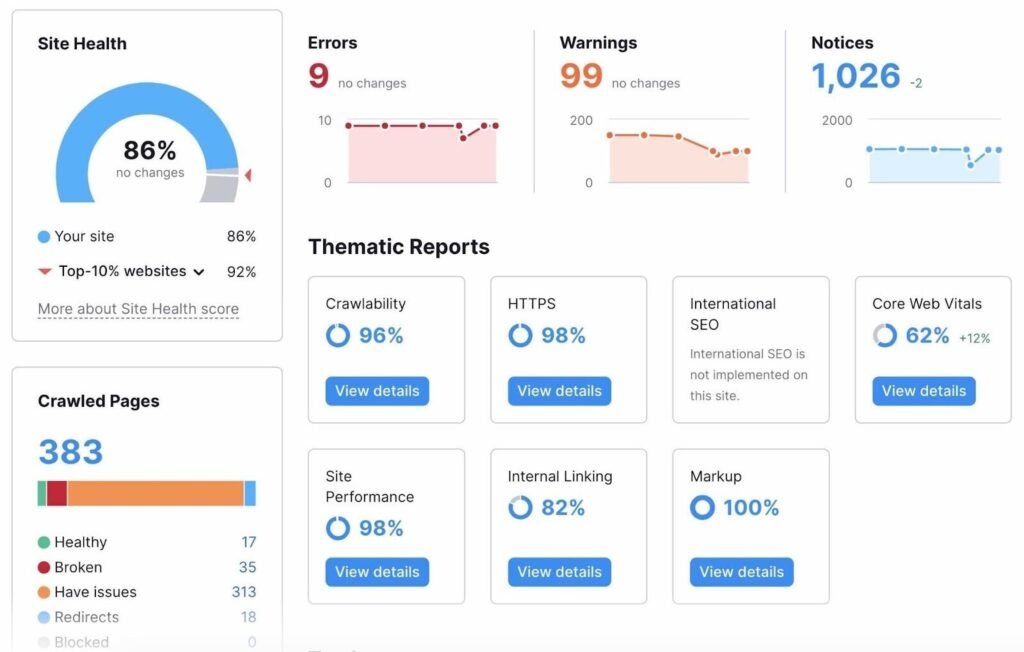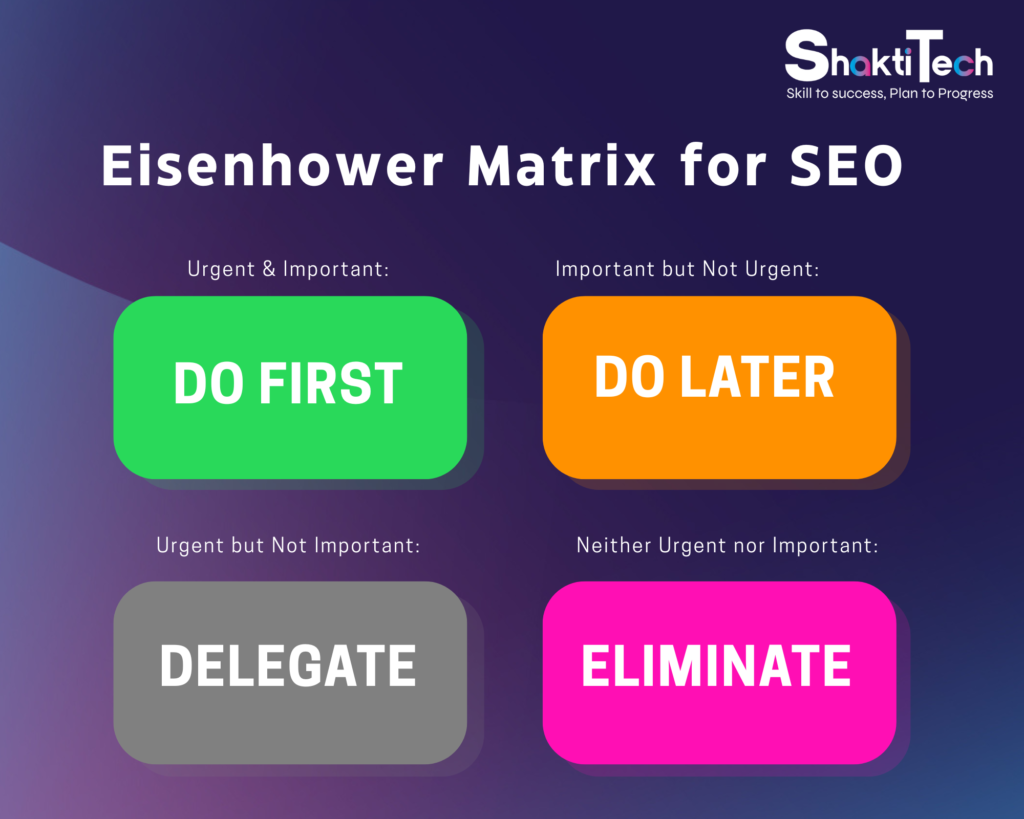
Table of Contents
SEO prioritization is crucial to any SEO strategy, ensuring that your efforts get the highest impact. In today’s competitive digital world, implementing SEO techniques is insufficient to get results.
You’ll need a structured approach to decide which SEO tasks should be done first.
Many marketers struggle with SEO task prioritization, they usually focus on those activities that don’t provide the best return on investment.
Should you need to improve technical SEO audit results, make changes in the content, or need to focus on backlinks first?
Understanding where to allocate SEO resources effectively can make all the difference in the search engine optimization success.
In this article. you’ll get a framework that help you how to prioritize SEO ranking factors wuisely. You’ll discover a mix of quick wins and long-term SEO strategy to boost your website rankings, improve visibility, and enhance user experience.
By following these best practices, you’ll ensure that your SEO efforts drive meaningful results efficiently.
Key Frameworks for Effective Prioritization
1. Technical SEO Assessment:
A technical SEO assessment is the foundation of your SEO strategy. It helps to identify and resolve critical issues that could negatively impact your site’s search engine optimization.

A well-implemented technical SEO audit ensures that search engines can effectively crawl, index, and rank your website, which improves visibility, and user experience.
Here are the different types of SEO audits and their benefits.
- Automated Audit:
An automated SEO audit is a quick, cost-effective method to identify basic issues on your site. Using tools like Google Search Console, Screaming Frog, and SEMrush, which help to detect basic errors such as broken links, missing meta data, and duplicate content.
While this type of technical audit is very beneficial for immediate insights, it may lack the depth needed for complex technical challenges. - Professional Audit:
A professional SEO audit is conducted by SEO experts who analyze your website performance with a structured approach. They use advanced tools and industry experience to identify hidden SEO ranking factors that may be limiting your growth.
This audit provides customized recommendations, ensuring that strategy is aligned with your business requirements. - In-Depth Technical Audit:
An in-depth technical audit is the most important evaluation, combining advanced tools with expert analysis. This audit is beyond the basic level issues, analyzing factors such as:
* Site structure & Crawability to ensure seamless navigation for search engines.
* Indexation status to confirm that important pages are indexed correctly.
* Mobile-friendliness & Core Web Vitals for user experience.
* Schema markup & structured data for better SERP Visibility.
A detailed SEO action plan is then created when you analyze critical issues and prioritize high-impact improvements.
Implementing these recommendations can lead to significant SEO success and sustainable ranking improvements.
Technical SEO assessments make sure that your website remains search-engine-friendly, secure, and fully optimized for long-term growth.
Breakdown of the Eisenhower Matrix for SEO
The Eisenhower Matrix divides the tasks into four sections to help you determine which ones need immediate attention, which require long-term planning, and which can be eliminated.

1. Urgent & Important: Tasks That Require Immediate Action
These are critical issues that, if not fixed immediately, can impact on your website’s search visibility, traffic, and user experience.
- Fixing Crawl Errors: Ensuring that search engine bots can properly access and index your pages.
- Resolving Indexing Issues: Addressing pages that are not indexed due to technical problems.
- Site Downtime or Security Issues: Fixing server errors, SSL certificate issues, or other errors.
- Fixing Broken Links: Ensuring users and search engines don’t land on the dead pages.
- Resolving Duplicate Content issues: Prevent Keyword cannibalization and improving rankings.
Action Plan: These tasks should be the top priority and addressed immediately to prevent ranking drops and loss of organic traffic.
2. Important but Not Urgent: Long-Term SEO Strategies
These tasks contribute to your website’s long-term success and sustainable rankings, but they do not require immediate action.
- Content Development: Creating high-quality, optimized content for targeted keywords.
- Keywords Strategy: Researching and implementing high-intent keywords that drive traffic.
- Link Building & Digital PR: Acquiring high-quality backlinks to improve domain authority.
- Improving Core Web Vitals: Optimizing page speed, interactivity, and visual stability for better user experience.
- Optimizing internal Linking: Improving site structure for better crawlability and link equity distribution.
Action Plan: Schedule these tasks weekly or monthly and make sure to do the consistent execution. These efforts may take time but provide long-lasting SEO benefits.
3. Urgent but Not Important: Minor Tasks With Low Impact
These tasks are time-sensitive but do not significantly affect your website’s SEO performance. While they should not be ignored, they should not take priority over critical issues.
- Updating Meta Descriptions & Title Tags: Optimizing them for CTR, but not at the cost of more SEO concerns.
- Fixing Redirect Chains & Minor URL Issues: Addressing them improves efficiency, but it will not directly impact on the rankings.
- Responding to Low-priority Alerts: Some SEO tools flag minor issues that do not require urgent action.
- Refreshing Outdated Content: Important, but can be scheduled after more urgent issues are resolved.
4. Neither Urgent nor Important: Low-Value Activities
These are the tasks that provide minimal SEO benefits and consume time without significant returns.
- Manually Checking Rankings Too often: Instead, use SEO reporting tools to automate rank tracking.
- Over-Optimizing Content for Keywords: Keyword stuffing harms SEO and user experience.
- Chasing Every Google Algorithm Update: Focus on evergreen strategies rather than constantly reacting to minor fluctuations.
- Analyzing Competitors Obsessively: It’s good to analyze the competitors, but excessive tracking may distracts you from execution.
The Pareto Principle (80/20 Rule) in SEO: Focus on What Truly Matters
The Pareto Principle, also known as the 80/20 Rule, which represents that 80% of results come from 20% of efforts. In SEO, this means that small efforts can generate high-impact optimizations that drive a high amount of organic traffic, rankings, and conversions.

Instead of spreading efforts across every possible SEO task, focusing on the 20% of activities that yield the highest results ensures efficiency and faster growth.
How the 80/20 Rule Applies to SEO Prioritization?
SEO involves hundreds of factors, but not all contribute equally to success. By analyzing your data, you can identify which actions provide the most significant impact and prioritize them.
1. Keyword Optimization: Target High-Performing Keywords
Not all keywords generate equal traffic and conversions. Instead of targeting low-value keywords, focus on:
- High-Search-Volume Keywords: Identify top-performing keywords that bring the majority of traffic.
- Long-Tail Keywords with High Intent: Target specific, intent-driven keywords that lead to conversions.
- Optimizing for Search Intent: Align content with user intent (informational, navigational, transactional).
- Improving Keyword Placement: Ensure proper keyword distribution in titles, meta descriptions, headings, and content.
80/20 Action Plan: Identify the top 20% of keywords that drive 80% of your traffic and optimize content around them for better visibility and ranking.
2. Content Enhancement: Improve Existing Content for Higher Engagement
Rather than constantly creating new content, revamping and optimizing existing content often provides a better ROI.
- Updating Old Content: Refresh outdated posts with current trends, statistics, and insights.
- Enhancing Readability & Structure: Improve content flow, add subheadings, bullet points, and visuals for better engagement.
- Optimizing for Featured Snippets: Answer common user queries clearly to capture Google’s Featured Snippet positions.
- Adding Internal Links: Strengthen site structure by linking to other high-value pages for SEO benefits.
- Improving Content Format: Include videos, infographics, and interactive elements to boost engagement and reduce bounce rates.
80/20 Action Plan: Identify the top-performing 20% of content and optimize it to maintain its ranking, boost engagement, and improve conversions.
3. Technical Fixes: Address Critical SEO Issues That Impact Rankings
SEO performance depends heavily on a website’s technical health. Instead of fixing every minor issue, prioritize technical elements that have the most significant impact on rankings.
- Site Speed Optimization: Improve page load speed to enhance user experience and reduce bounce rates.
- Mobile-Friendliness: Ensure responsive design and mobile usability to rank higher in Google’s mobile-first indexing.
- Fixing Crawl Errors: Use Google Search Console to detect and resolve crawlability issues.
- Core Web Vitals Optimization: Focus on Largest Contentful Paint (LCP), First Input Delay (FID), and Cumulative Layout Shift (CLS) for better performance.
- Fixing Duplicate Content Issues: Use canonical tags and remove unnecessary duplicate pages to prevent keyword cannibalization.
80/20 Action Plan: Focus on the 20% of technical fixes that improve 80% of site performance and directly impact SEO rankings.
Balancing Quick Wins and Long-Term Strategies in SEO:
SEO is a long-term game, but that doesn’t mean you can’t see quick results. The key to a successful SEO strategy lies in balancing immediate-impact quick wins with long-term sustainable growth tactics.
Focusing only on quick fixes might yield temporary traffic boosts, but without long-term SEO efforts, rankings won’t sustain. Similarly, if you invest only in long-term strategies, you might miss short-term opportunities to improve site performance.
Quick Wins: Immediate Impact for Faster Results
Quick wins are SEO optimizations that deliver fast results without requiring months of effort. These small yet effective changes help improve search visibility, user experience, and site performance quickly.
- Speed Optimization: Improve Page Load Time for Better UX & Rankings
- Why it Matters? Google prioritizes fast-loading websites in search rankings. A slow site leads to higher bounce rates, negatively affecting SEO.
- Quick Fix: Optimize images, enable browser caching, use a Content Delivery Network (CDN), and minimize HTTP requests.
- Impact: Faster site speed improves user experience and SEO rankings almost immediately.
2. Fixing Broken Links: Enhance Crawlability & Prevent SEO Issues
- Why it Matters? Broken links lead to 404 errors, which affect both user experience and search engine crawlability.
- Quick Fix: Use tools like Google Search Console, Screaming Frog, or Ahrefs to find broken links and redirect or replace them.
- Impact: Improved site navigation and crawl efficiency, leading to better indexation and user experience.
3. Metadata Optimization: Boost Click-Through Rate (CTR)
- Why it Matters? Well-optimized title tags and meta descriptions increase the likelihood of users clicking on your search result.
- Quick Fix:
✔Write engaging, keyword-rich meta descriptions.
✔ Keep title tags within 50-60 characters for better readability.
✔ Use power words & numbers (e.g., “10 Proven SEO Tips for 2024”). - Impact: Higher CTR leads to better rankings, as Google considers user engagement signals in its algorithm.
Long-Term SEO Strategies: Building Sustainable Growth
SEO success isn’t just about quick fixes; it requires long-term planning and consistent effort to achieve sustainable growth, higher rankings, and brand credibility. While quick wins provide immediate results, a well-planned long-term SEO strategy ensures your website maintains its authority and visibility in search engines.
Here’s a detailed breakdown of three essential long-term SEO strategies that drive consistent organic traffic and long-lasting results.
- Content Marketing: Create High-Value, Keyword-Rich Content
- Why it Matters? Content is the foundation of SEO. Search engines prioritize valuable, relevant, and optimized content that provides real value to users. A strong content strategy helps establish your website as an authority, improving rankings and attracting organic traffic.
Long-Term Strategy: Publish SEO-friendly blog posts, guides, and case studies to provide value-driven content for your audience.
✔ Focus on user intent-based keyword targeting to match search queries with the right content.
✔ Repurpose content into videos, infographics, and social media snippets to reach a wider audience.
✔ Maintain content freshness by updating old blog posts with new data and insights.
2. Link Building: Strengthening Your Website’s Domain Authority
Why it Matters? When high-authority sites link to your content, it signals to Google that your website is valuable and trustworthy. A strong backlink profile directly influences your website’s domain authority and ranking potential.
Long-Term Link Building Strategy:
Guest Posting on high-authority websites to gain quality backlinks.
✔ Earning editorial backlinks by creating high-value, share-worthy content.
✔ Building resource pages that attract natural backlinks (e.g., infographics, industry reports, and research studies).
✔ Establishing brand partnerships and influencer collaborations to gain mentions and links
Impact:
✔ Increased domain authority, leading to higher rankings in search results.
✔ More referral traffic from websites linking to your content.
✔ Improved credibility and trustworthiness in your industry.
Executing and Continuously Improving Your SEO Strategy:
A well-structured SEO plan ensures sustainable growth, improved search rankings, and long-term success. Execution plays a crucial role in turning SEO strategies into measurable results. Without a structured approach, efforts can become scattered, leading to inefficient resource allocation.
Here’s a detailed breakdown of how to effectively implement and continuously improve your SEO strategy for maximum impact.
- First 30 Days: Focus on Quick Wins
The first month should be dedicated to fixing technical issues and implementing quick SEO improvements that yield instant results. These low-effort, high-impact changes help enhance user experience and search visibility.
Key Quick Wins to Focus On:
✔ Technical SEO Fixes: Resolve crawl errors, broken links, and indexation issues.
✔ Metadata Optimization: Improve title tags, meta descriptions, and header tags for better CTR.
✔ Site Speed Improvements: Optimize images, enable caching, and minify code to enhance load time.
✔ Mobile Optimization: Ensure your site is responsive and performs well on mobile devices.
2. Next 60-90 Days: Shift to Long-Term Strategies
Once the technical foundation is in place, focus on long-term SEO strategies that drive sustained growth. These strategies take time to show results but are crucial for long-term success.
Key Long-Term Strategies to Implement:
✔ Content Marketing: Publish high-value, keyword-rich content that aligns with search intent.
✔ Keyword Optimization: Focus on high-performing keywords that attract targeted traffic.
✔ Backlink Acquisition: Build high-authority backlinks through guest blogging, influencer collaborations, and content outreach.
✔ User Experience Enhancement: Improve site navigation, internal linking, and Core Web Vitals.
3. Ongoing Process: Continuous Monitoring & Adaptation
SEO is an ongoing effort that requires constant monitoring, analysis, and adaptation. Keeping up with SEO best practices ensures that your website remains competitive and optimized for changing algorithms.
Essential Ongoing SEO Tasks:
✔Track keyword performance and search rankings using tools like Google Search Console & Ahrefs.
✔ Conduct regular SEO audits to identify new issues and optimization opportunities.
✔ Update existing content with fresh insights, statistics, and relevant keywords.
✔ Adapt strategies based on Google algorithm updates and industry trends.
Continuous Improvement and Learning
SEO is constantly evolving, and staying updated with the latest trends, algorithm updates, and industry insights is crucial for maintaining a competitive edge.
📌 How to Stay Ahead in SEO:
✔ Follow SEO Experts & Blogs 📖
Stay informed by following industry leaders like Google Search Central, Moz, Ahrefs, and Search Engine Journal.
✔ Attend Webinars & SEO Conferences
Participate in SEO summits, online workshops, and industry events to gain insights from experts.
✔ Experiment with New SEO Tools & Strategies
Test AI-powered SEO tools, automation techniques, and new ranking factors to stay ahead.
✔ Network with Industry Professionals
Join SEO communities and forums (like SEO Slack groups and Reddit discussions) to exchange knowledge and learn from peers.
Conclusion
A structured SEO plan combined with continuous learning and adaptation ensures long-term organic growth and higher rankings. By implementing quick wins, long-term strategies, and ongoing optimizations, you can build a resilient SEO strategy that withstands algorithm updates and industry shifts.
Are you ready to execute your SEO plan? Start today and take your search rankings to the next level!
FAQs
Why is SEO prioritization important?
It helps focus on high-impact tasks that boost rankings, increase traffic, and improve site health efficiently.
What SEO tasks should I prioritize first?
Commence with the technical fixes (site speed, crawl issues), optimize high-traffic pages, and improve internal linking.
How do I balance quick wins with long-term SEO?
Fix technical issues first for fast results, then invest in content marketing, link building, and regular audits.
How often should I do an SEO audit?
Do a mini-audit monthly and a full audit every 3-6 months to stay ahead of algorithm updates.
How do I measure SEO success?
Track organic traffic, keyword rankings, engagement metrics, and site performance in Google Analytics & Search Console.

Leave a Reply